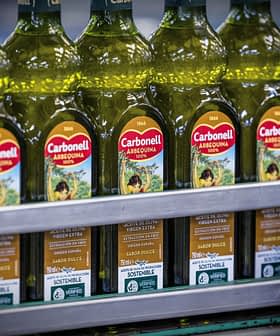Table Olive Sales Open Year Sharply Higher
Sales of table olives were sharply higher in China, Australia, Canada, Japan, and Brazil for the first two months of the current campaign, according to the International Olive Council, while olive oil prices have risen dramatically.
The world eats more table olives.
According to the latest information from the International Olive Council (IOC), global consumption of olives has increased by 182 percent since 1990.
Most of the rise has occurred within the Mediterranean region where production has followed demand. Egypt, Algeria, and Turkey over the period went from consuming 11,000, 14,000 and 110,000 tons to 400,000, 244,000 and 350,000 tons respectively.
In the European Union, consumption over the same period rose by 78 percent, going from 346,500 to 618,000 tons. Spain, the largest European producer, was also the main consumer per capita at 4.1 kg, followed by Cyprus with 3.1 kg, and Malta with 1.9kg.
Olive Oil Consumption Up in Key Markets
There was some good news for the international sales of olive oil and olive pomace oil in the IOC numbers pertaining to the 2016/17 crop year. In the first two months (October and November 2016) consumption of olive oil and olive pomace oil rose in China (99 percent), Australia (65 percent), Canada (42 percent), Japan (17 percent), Brazil (16 percent) and the United States (5 percent) compared to the same period a year earlier.
Intra-EU acquisitions rose by 24 percent in October 2016, but extra-EU imports fell by 56 percent compared to October 2016.
Olive Oil Prices
Spanish prices reached €3.64/kg at the end of January 2017, a 10 percent increase compared to January 2016.
Italian producer prices started picking up in mid-August, accelerated in the first week of November and reached €5.90/kg at the end of January 2017 (a 70 percent year-over-year increase).
Greek producer prices remained steady from mid-August through the end of October and went up near the end of January 2017 when they reached €3.46/kg (a 17 percent increase compared to January 2016).
The same trend was observed for refined olive oil prices in Spain and Italy. At the end of January 2017, the price difference in Spain between refined and virgin olive oil was €0.10/kg. In Italy, the price difference between the two categories was far greater, at €2.28/kg.
Health Benefits Reported
Table olives were found to boost the immune system and, the IOC said, just might be the perfect fermented probiotic vegetable product of the future. This is due to the fact that some of the lactic acid bacteria generated in the fermentation of table olives fared better than other forms of bacteria widely recognized as probiotic microorganisms.
The regular consumption of olives helps provide the daily recommended intake of fiber, and olives are a source of oleic acid, carbohydrates, and protein. Olives were also found to contain vital minerals such as sodium, iron, calcium and magnesium, and the antioxidant properties of polyphenols and provitamins A and E.








